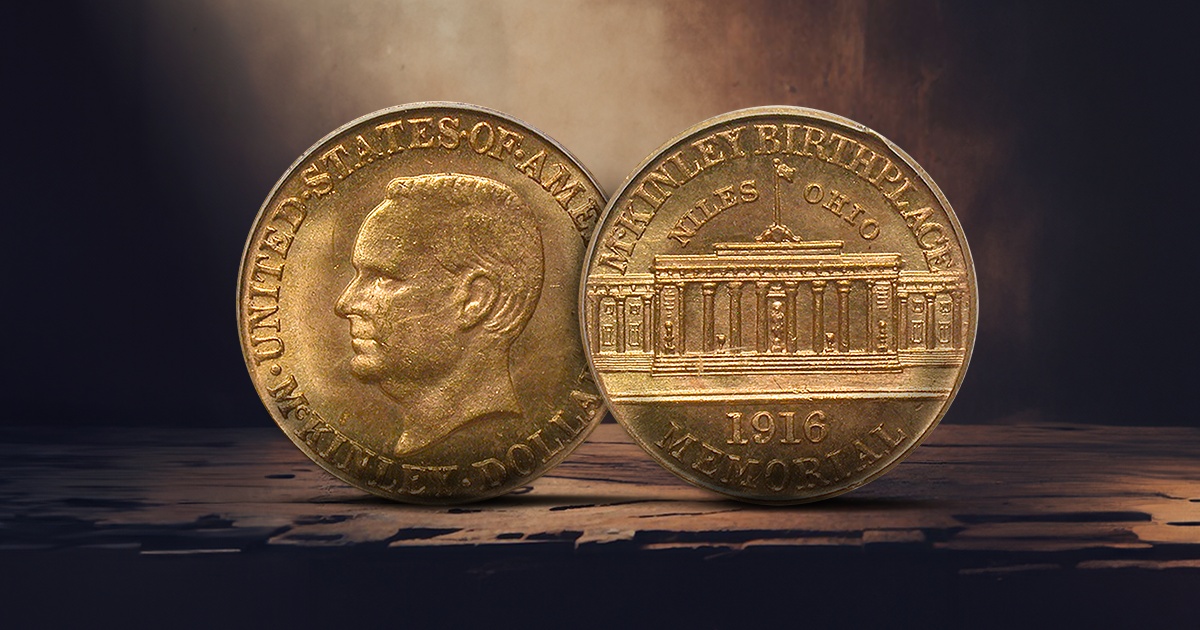
The McKinley Memorial dollar, or the McKinley Birthplace Memorial dollar, is a gold commemorative coin struck in 1916 and 1917 to raise funds for the McKinley Birthplace Memorial. The coin depicts a profile of William McKinley, the 25th United States President.
Design of the McKinley Memorial Dollar
The McKinley Birthplace Memorial dollar was designed by George T. Morgan and Charles E. Barber. Since McKinley had already appeared on one of the Louisiana Purchase Exposition dollars in 1903, the McKinley Memorial dollar made him the first person depicted on two different pieces of US coinage.
The obverse was designed by Barber and featured a profile of William McKinley around which are the words UNITED STATES OF AMERICA – McKINLEY DOLLAR. Critics agreed that Charles E. Barber had tried to make this portrait as unique from the Louisiana Expo dollar as possible, which resulted in an overly Roman depiction of McKinley.
Morgan designed the reverse, which depicted a view purported to face the memorial, although some critics described the view as inaccurate to real life. Above the memorial were the words McKINLEY BIRTHPLACE – NILES OHIO with the date and word MEMORIAL below the building.
William McKinley’s Background
William McKinley was born in 1843 in Niles, Ohio, and spent his life serving the nation. McKinley first worked as an educator before serving in the Union Army during the Civil War. President McKinley was the last United States President to serve in the Civil War and the only President who began a war as an enlisted soldier and ended it as a brevet major. After the Civil War, McKinley attended law school and started a practice in Canton, Ohio. In 1876, William McKinley was elected to Congress, and although he lost a bid for re-election, he won the Ohio governorship in 1891 and served as the Governor of Ohio for two terms.
William McKinley’s Political Career and Presidency
While campaigning for the Presidency against William Jennings Bryan, McKinley championed the cause of sound money. He was an advocate of the gold standard and believed that a system of high tariffs would restore the nation to its pre-depression prosperity following the Panic of 1893. Bryan was an advocate of the free coinage of silver and McKinley’s emphasis on the gold standard helped foster the Republican nomination.
McKinley beat Bryan in the Presidential election and was Commander-in-Chief during the Spanish-American War of 1898. Following a decisive victory, the United States gained former Spanish territories like Guam, Puerto Rico, and the Philippines.
McKinley’s Second Term as President
In the 1900 election, William McKinley won his re-election bid against William Jennings Bryan, who advocated for free silver, but his triumph was short-lived. A mere six months into McKinley’s second term as President, he was shot in the Temple of Music at the Pan-American Exposition in Buffalo, New York. While the President was shaking hands with the public, Leon Czolgosz, an anarchist who had lost his job in the Panic of 1893, shot him twice. President McKinley died from the gangrene caused by the attack 8 days later.
The McKinley Birthplace Memorial Dollar
Following President McKinley’s assassination, Theodore Roosevelt assumed the Oval Office, and the nation grieved. A little more than nine years later, funding for the National McKinley Birthplace Memorial Library and Museum was authorized, and the National McKinley Birthplace Association was established. A childhood friend of McKinley, Joseph G. Butler, had already raised close to $200,000 and acted as the association’s president.
Butler urged Ohio Congressperson William A. Ashbrook to push for a commemorative silver dollar to honor the late President. Ashbrook had to file his bill twice and upon a second introduction, a hearing was held to discuss the matter. Although the McKinley Birthplace Memorial dollar was intended to be a silver commemorative coin, it made more sense to issue it as a gold dollar. At the hearing, Butler suggested changing the composition of the McKinley Birthplace Memorial Commemorative from silver to gold to honor McKinley’s memory and advocacy of the gold standard.
A circulating gold dollar had not been struck in 27 years, since 1889. Senator Warren G. Harding spoke in favor of the bill, as it would be funded by the Association and would only cost the US government the price of the coin dies. After changing the language of the bill to reflect the change in composition and setting the number of dollars at 100,000, the bill passed the House on February 7 and the Senate on the 15th of February 1916. Woodrow Wilson signed it into law on February 23, and of the 30,000 coins produced, 10,000 were later melted.




